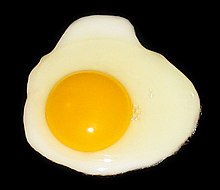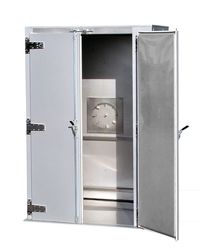Heat disinfestation
The heat disinfestation is a method of pest control and is based on the principle that mites , beetles and moths or their egg-laying, larvae , pupae , at a temperature from about 42 ° C by protein - clotting are killed. It is often used in flour mills , warehouses and similar operations to avoid the use of pesticides .
The treatment
There are two thermal processes (heating of the air using special ovens provided for this purpose):
- cold outside air is heated and forced through the building
- only the room air is heated in the circulating air process
Hardly any preparatory measures are necessary for a heat disinfestation treatment. It is sufficient to close windows, doors and other wall openings. Machines or conveyor systems do not have to be dismantled or opened, just run empty. The number of heat disinfestation ovens to be used is determined by the building construction, room volume, systems and facilities. The ovens slowly heat the entire room air using the circulating air process. The thermostats ensure that the killing temperature between a minimum of 50 ° C and a maximum of 60 ° C is maintained anytime and anywhere. This guarantees an optimal effect and excludes heat damage to the building or the infrastructure. The duration of the treatment depends on the volume of the room and it must be ensured that the target temperature is maintained for at least 12 to 40 hours so that an optimal exposure time is achieved in machines and cavities.
In the industrial sector, heat disinfestation in a heating chamber makes the most sense in terms of energy. B. is required almost continuously in pallet production. A heating chamber has very thin inner walls and an insulation layer, mostly rock wool , between the inner walls and the outer jacket. When heating, only the inner walls have to be heated up so that a uniform temperature distribution is achieved. A fresh air supply is not necessary for the heat disinfestation and thus the energy requirement for this can also be saved. Energy costs are the largest part of operating costs. Today, thermostats are no longer used to regulate the temperature, but electronic PID controllers . This eliminates the switching hysteresis and a fixed temperature can be adjusted with almost no wear and tear, without "overshoots" during heating.
- Heat chambers for heat disinfestation are preferably designed in a drivable version. This eliminates manual loading and unloading. While the product is being retracted, the chamber is only opened briefly and thus the loss of heat is also minimal.
- Usually these heating chambers are now equipped with an electronic temperature controller, a motorized air circulation system, a temperature limiter and an electrical heater made of tubular heating elements. The electronic temperature controller now replaces the thermostat, which is usually very expensive and imprecise. The motorized air circulation ensures that the same temperature is reached in the entire usable space and thus the heat treatment in the entire usable space is ensured. In addition to the controller, the temperature limiter monitors the temperature in the chamber. In the event of a fault in the regulator or the control system, the temperature limiter switches off the heating completely so that there is no danger to the product, the heating chamber or the environment.

